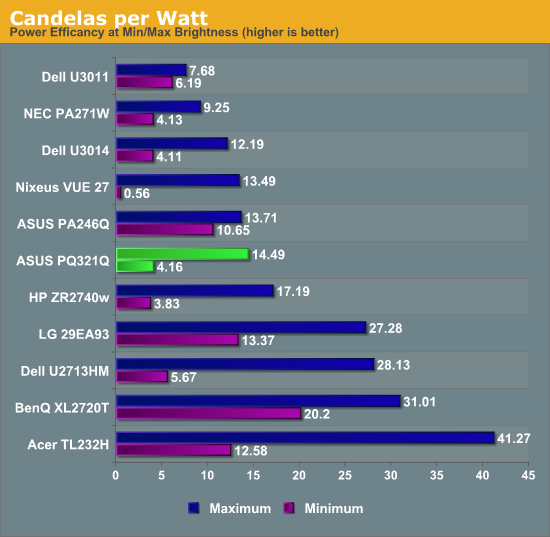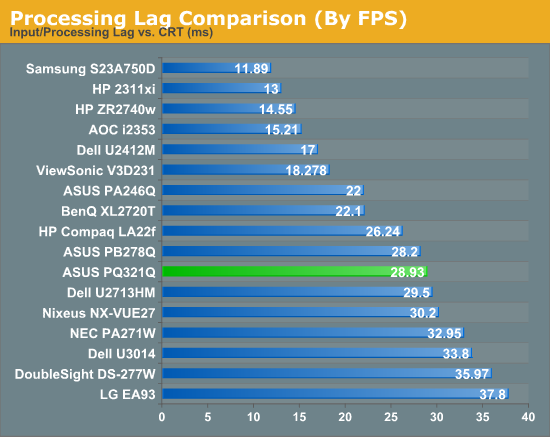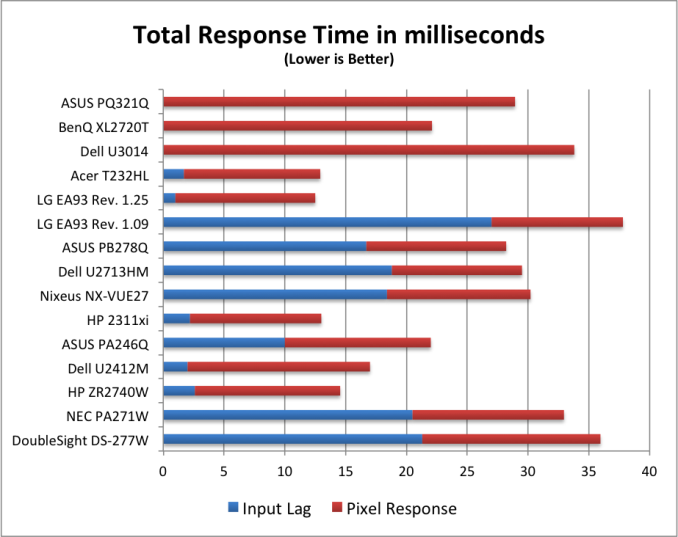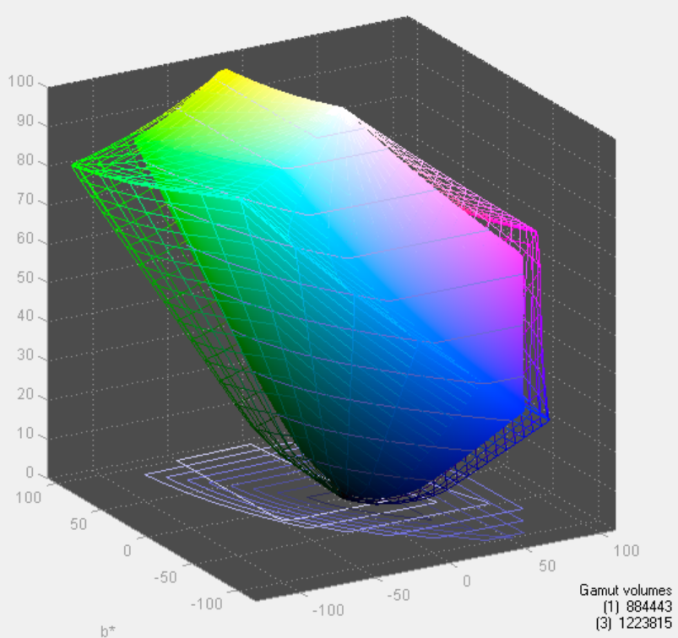ASUS PQ321Q UltraHD Monitor Review: Living with a 31.5-inch 4K Desktop Display
by Chris Heinonen on July 23, 2013 9:01 AM ESTUsing the updated metric for power usage, where I factor in maximum brightness and screen area and not just power usage, the ASUS PQ321Q falls right in the middle of the pack. For both maximum and minimum brightness it does OK but not incredible in comparison to other displays. With the greater transmission of IGZO I would have thought I might see better numbers from the ASUS, but I imagine power usage was very low on the list of concerns relative to other performance numbers.
Overall the ASUS PQ321Q draws a relatively average amount of power compared to other displays.


For testing input lag, I’m again reduced to using the Leo Bodnar lag tester over HDMI. This also means that the ASUS will have to scale the 1080p signal to be 2160p and fill the screen. Unlike before, I think this might be a more accurate test as many people will not be gaming at 2160p yet. Looking at the gaming numbers that our Ian Cutress found with a 4K display, you might want to run at 1080p for a little bit until setting up a 4x Titan rig becomes more affordable. Then again, if you can afford the ASUS PQ321Q, you might be buying a 4x Titan setup as well.
Back to the actual data, and the ASUS comes in at 28.93 ms of lag on average for the 3 measurement locations. This is better than the Dell U3014 monitor does, but slower than the BenQ XL2720T that is a native 1080p display. Given that you have scaling going on here, this actually is a pretty decent result I think.

Despite my GPU only being a GTX 660 Ti, I did try out a little bit of gaming on the ASUS. One question that was debated in Ian’s round-up was the necessity of MSAA at 4K resolutions. Measuring just now, I sit exactly 2’ away from the ASUS PQ321Q, with my eyes around dead center on the display. Turning on Half Life 2 (look, I’m not much of a gamer!), I can easily see the difference between no MSAA, 2x and 4x MSAA. The pixel density would need to be even higher, or I’d need to sit further away, for MSAA to not make a difference.
Without MSAA things still looked very sharp overall, but jagged lines are easy to spot if I look for them. You might be able to more easily get away with 2x or 4x instead of 8x MSAA, but you’ll want to have it enabled. Beyond that, the PQ321Q worked well for my casual gaming. Nothing recognized the display correctly at first, perhaps because of MST, but once in the game you can properly select the 3840x2160 resolution for it.
At the request of a commenter I'm adding some PixPerAn photos, trying to show best and worst case results. I've not used PixPerAn at all before, so feedback would be great. If I've done something wrong with it, I'll try to correct it ASAP.
Looking at the gamut, we see a value that indicates full sRGB gamut coverage. From our earlier images of the CIE diagram we know we don’t have full coverage of red, blue and magenta. It seems the extra green/yellow/orange section is large enough that we get a value that indicates a volume equal to the sRGB space, but some of that volume is an area outside of sRGB. It is close to the sRGB area, but not quite.


















166 Comments
View All Comments
Mondozai - Tuesday, July 23, 2013 - link
BUT BUT BUT, we were told everything above 720p was overkill and stupid!Where are Anandtechs resident armchair experts now?!
Despoiler - Tuesday, July 23, 2013 - link
It depends on how close you are to the display and the size of the display. 4k will definitely help in a computing environment. It will do no good in common TV viewing scenarios. 4k will however sell TVs because you typically buy TVs at the store where you are up close to it. http://carltonbale.com/does-4k-resolution-matter/beginner99 - Tuesday, July 23, 2013 - link
Exactly. Most people either have a too small tv or sit too far away to even benefit from ful HD or even 720p.kevith - Tuesday, July 23, 2013 - link
Well, doesn´t that depend on what you mean by "benefit"? (I know the eyes have an upper limit, when it comes to resolution, giving a max distance from your TV/monitor)I have never experienced a High DPI screen - like a Retina - in real life, but I know a great deal about the difference when it comes to sound.
What is it excactly, that makes a 2000 dollar stereo set better than a 500 dollar one? It´s very hard to put your finger on one parameter and say.: "It´s that!" or "It´s this!" "Better transients" or "better bass" are just subjective expressions.
At the end of the day, it very often comes down to: "It simply sounds "softer" to my ears". Or: "You can turn the volume up way higher, before it starts to sound harsh or rough".
I don´t know, I just presume it´s the same with screens: The higher the res, the "softer" the picture wil feel to your eyes. Even if we actually exceed the resolution capabilities of the eye.
Despoiler - Tuesday, July 23, 2013 - link
It's that your eyes physically cannot resolve the difference in resolution at a certain distance combined with a certain size of screen. ie 720, 1080, or 4k look the same if you are sitting far enough back.Integr8d - Wednesday, July 24, 2013 - link
720p is rougly the maximum visual acuity for a moving image. For static images, the more resolution the better. For movies or gaming (save for the occasional sniper shot, where most of the screen is still) 720p is most your brain can process.shaurz - Wednesday, July 24, 2013 - link
That sounds like bollocks to me. I can easily tell the difference between a game running at 720p and 1080p.doobydoo - Thursday, July 25, 2013 - link
He said 'if you are sitting far enough back'. Can you tell the difference between a game running at 720p and 1080p from 1 mile away? No.Ortanon - Wednesday, July 24, 2013 - link
...at a certain viewing angle [distance].Shadowself - Wednesday, July 24, 2013 - link
Absolutely not. Please read my earlier post.Additionally, motion actually enhances a lot of the acuity requirements. You can actually see motion (especially if it's repetitive) that is on the order of one arc minute or less.